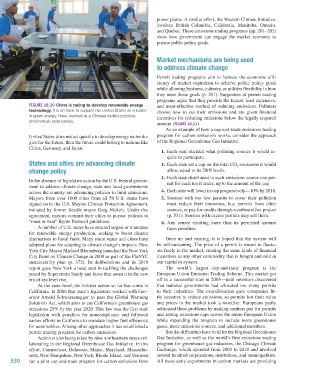Page 531 - Environment: The Science Behind the Stories
P. 531
power plants. A similar effort, the Western Climate Initiative,
involves British Columbia, California, Manitoba, Ontario,
and Quebec. These emissions trading programs (pp. 201–202)
show how government can engage the market economy to
pursue public policy goals.
Market mechanisms are being used
to address climate change
Permit trading programs aim to harness the economic effi-
ciency of market capitalism to achieve public policy goals
while allowing business, industry, or utilities flexibility in how
they meet those goals (p. 201). Supporters of permit trading
programs argue that they provide the fairest, least expensive,
Figure 18.30 China is racing to develop renewable energy and most-effective method of reducing emissions. Polluters
technology. It is on track to surpass the United States as a leader choose how to cut their emissions and are given financial
in green energy. Here, workers at a Chinese factory produce incentives for reducing emissions below the legally required
photovoltaic solar panels.
amount (Figure 18.31).
As an example of how a cap-and-trade emissions trading
United States does not act quickly to develop energy technolo- program for carbon emissions works, consider the approach
gies for the future, then the future could belong to nations like of the Regional Greenhouse Gas Initiative:
China, Germany, and Japan.
1. Each state decided what polluting sources it would re-
quire to participate.
States and cities are advancing climate 2. Each state set a cap on the total CO emissions it would
2
change policy allow, equal to its 2009 levels.
3. Each state distributed to each emissions source one per-
In the absence of legislative action by the U.S. federal govern- mit for each ton it emits, up to the amount of the cap.
ment to address climate change, state and local governments
across the country are advancing policies to limit emissions. 4. Each state will lower its cap progressively—10% by 2018.
Mayors from over 1000 cities from all 50 U.S. states have 5. Sources with too few permits to cover their pollution
signed on to the U.S. Mayors Climate Protection Agreement, must reduce their emissions, buy permits from other
initiated by former Seattle mayor Greg Nickels. Under this sources, or pay for credits through a carbon offset project
agreement, mayors commit their cities to pursue policies to (p. 531). Sources with excess permits may sell them.
“meet or beat” Kyoto Protocol guidelines. 6. Any source emitting more than its permitted amount
A number of U.S. states have enacted targets or mandates faces penalties.
for renewable energy production, seeking to boost cleaner
alternatives to fossil fuels. Many more states and cities have Once up and running, it is hoped that the system will
adopted plans for adapting to climate change’s impacts. New be self-sustaining. The price of a permit is meant to fluctu-
York City Mayor Michael Bloomberg launched the New York ate freely in the market, creating the same kinds of financial
City Panel on Climate Change in 2008 as part of the PlaNYC incentives as any other commodity that is bought and sold in
sustainability plan (p. 372). Its deliberations and its 2010 our capitalist system.
report gave New York a head start in tackling the challenges The world’s largest cap-and-trade program is the
posed by Superstorm Sandy and those that await it in the new European Union Emission Trading Scheme. This market got
era of sea level rise. off to a successful start in 2005—until investors discovered
At the state level, the boldest action so far has come in that national governments had allocated too many permits
California. In 2006 that state’s legislature worked with Gov- to their industries. The overallocation gave companies lit-
ernor Arnold Schwarzenegger to pass the Global Warming tle incentive to reduce emissions, so permits lost their value
Solutions Act, which aims to cut California’s greenhouse gas and prices in the market took a nosedive. Europeans partly
emissions 25% by the year 2020. This law was the first state addressed these problems by making emitters pay for permits
legislation with penalties for noncompliance and followed and setting emissions caps across the entire European Union
earlier efforts in California to mandate higher fuel efficiency while expanding the program to include more greenhouse
for automobiles. Among other approaches it has established a gases, more emissions sources, and additional members.
permit trading program for carbon emissions. Similar difficulties have befallen the Regional Greenhouse
Action is also being taken by nine northeastern states col- Gas Initiative, as well as the world’s first emissions trading
laborating in the Regional Greenhouse Gas Initiative. In this program for greenhouse gas reduction, the Chicago Climate
effort, Connecticut, Delaware, Maine, Maryland, Massachu- Exchange, which operated from 2003 to 2010 and involved
setts, New Hampshire, New York, Rhode Island, and Vermont several hundred corporations, institutions, and municipalities.
530 run a joint cap-and-trade program for carbon emissions from All these early experiments in carbon markets are providing
M18_WITH7428_05_SE_C18.indd 530 12/12/14 4:05 PM

